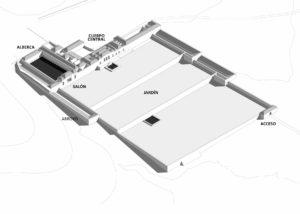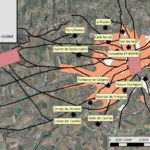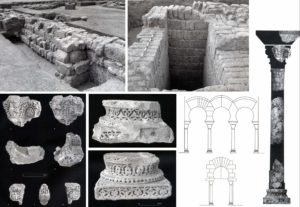
Palaces and almunias

The almunias of the elites were characteristic properties of the productive landscape of the urban periphery of the Umayyad capital. They had an important palatial space, to which their owners could temporarily go: emirs, caliphs and other relevant characters who used the sumptuousness of these spaces for ostentation and representation of power, both for the wealth of their facilities and for the exhibition of capacity economic to create and maintain them.

They also functioned as complex agricultural spaces that could provide significant yields, and in which there were important irrigated areas for the cultivation of fruit and vegetables, perishable products that were traded in nearby urban markets. In them it was also common the presence of large areas of dry land, livestock and even facilities related to the manufacture of manufactures.

The first Umayyad emir of the West, ‘Abd al-Rahman I (756-788), built the first almunia in the north of Cordoba: al-Rusafa, named after a property of his grandfather, the caliph Hisham, in Resafa (Syria). This type of foundations will suffer a progressive development in coming years, especially in the 10th century, coinciding with the stability of al-Andalus and the proclamation of the Umayyad Caliphate of the West by ‘Abd al-Raḥmān III (929). Among the dozens of almunias found in the Omeya Cordova we can highlight Munyat Al-Naura, located next to the river and in a road that connected the Alcazar of Cordoba and Madinat al-Zahra; or Munyat Al-Rummaniya, next to the new palatine city, in the foothills of the mountains, and from which many of its structures are still preserved, such as the large pool that irrigated the nearby garden space.
Bibliography
ANDERSON, G., (2013): The Islamic Villa in Early Medieval Iberia: Architecture and Court Culture in Umayyad Córdoba, Burlington, VT: Ashgate,.
ARNOLD, F. (2010): “Eine islamische Palastanlage am Stadtrand von Córdoba”, Madrider Mitteilungen, 51, pp. 419-454.
ARNOLD, F.; CANTO GARCIA, A.; VALLEJO TRIANO,A. (2015): Munyat ar-Rummaniya: Ein Islamischer Landsitz bei Córdoba.
CAMACHO CRUZ, C. (2010): “La almunia de la Ronda Oeste.Un hito en la arqueología cordobesa”, Arte, Arqueología e Historia, 17, pp. 173-181.
LÓPEZ CUEVAS, F. (2013): “La Almunia Cordobesa, entre las fuentes historiográficas y arqueológicas Fernando Universidad de Córdoba”, Onoba, 1, pp. 243-260.
LÓPEZ CUEVAS, F. (2014): “Las almunias de Madīnat Qurṭuba. Aproximación preliminar y nuevos enfoques”, Revista Anahgramas, I, pp. 161-207.
MURILLO REDONDO, J. F. (2009): “La almunia de al-Rusafa en Córdoba”, Madrider Mitteilungen, 50, pp. 449-490.
MURILLO REDONDO, J.F. (2014): “Grandes residencias suburbanas en la Córdoba Omeya. Estado de la cuestión”, Al-Mulk, 12, pp. 85-108.
MURILLO, J. F.et alii (2010): “La almunia y el arrabal de al-Rusafa, en el Ŷānib al-Garbi de Madīnat Qurtuba” en VAQUERIZO GIL, D.; MURILLO REDONDO, J. F.: El anfiteatro romano de Córdoba y su entorno urbano. Análisis arqueológico (ss. I-XIII), vol. 2, pp. 565-615.

